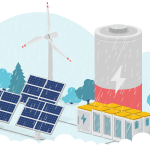The Devil’s in the Details: 3 More Killer Clauses in Sustainable & Clean Technologies Contracts
May 12, 2022

In the event of a dispute, lawsuit, or a claim, your contract is one of the first places the courts will check to see what you agreed to and who’s at fault. Unfortunately, in the Sustainable & Clean Technologies industry, if you don’t read the fine print carefully, you might find yourself taking responsibility for risks that aren’t always in your control, like bad weather, energy output, supply chain disruptions, and more. That means an unclear, poorly written contract won’t just lead to budget issues or scope creep; it could also expose your firm to costly litigation, crippling damages, and lasting reputational harm.

Whether you design, develop, distribute, or produce clean technologies, there are several killer clauses in every contract that you should keep an eye out for. We’ve already done a deep dive on three of them—what they are, why they’re risky, and what you can do about them. Here are three more.
RELATED: 3 Killer Clauses in Sustainable & Clean Technologies Contracts
Disclaimer: Please note the information provided herein offers guidelines only and is presented from a liability-based perspective to help you avoid insurance claims. It is not exhaustive and should not take the place of legal advice, nor will it apply to all businesses, settings, and circumstances. For specialized guidance on contract practices, please consult a lawyer.
1. Force Majeure
WHAT IS IT?
A force majeure clause excuses you from failing to perform due to an unforeseeable event. If a fire destroys your factory or severe flooding delays your shipment schedule or some other extenuating circumstance prevents you from fulfilling your contractual obligations, a force majeure clause means you won’t be held liable. As a rule of thumb, a force majeure clause should always be included in commercial contracts in case of supply chain issues.
WHAT’S THE RISK?
Like all clauses, the application of a force majeure is contingent on the language of the provision. Unfortunately, there’s no universal definition for what constitutes a force majeure, with most contracts describing it as “any event beyond the reasonable control of the involved parties.” That means a force majeure could be anything from a natural disaster, to labour disputes and work stoppages, to armed conflict to legislative changes to a public health crisis. Ultimately, broad language leaves it up to the stakeholders to decide what events fall within the criteria.
Additionally, for a force majeure to kick in, you have to be able to prove to the courts that:
- You couldn’t have reasonably predicted the event at the time the contract was drafted;
- You couldn’t have prevented, avoided, or overcome the effects of the event; and
- It was truly impossible (and not just inconvenient) for you to perform.
Here’s an example: you’re waiting on a key shipment from BC. But due to forest fires, the rail lines are damaged. While your materials are unharmed, the shipment containers are offloaded in Vancouver and can’t be delivered until the rail lines reopen. Your project is delayed for weeks until the backlog is resolved. Without a force majeure clause in place, your client could hold you liable for the delay.
WHAT CAN YOU DO?
- Don’t use generic language. Tailor your force majeure clause to address shifting business needs and relationships, as well as the period of time during which you can enforce it.
- Be sure to distinguish between bad weather and more severe conditions, particularly when it comes to renewables and power generation. Take your geographic region into account; you may need to include a greater range of weather conditions.
- Make sure you also include exceptions (events that aren’t considered a force majeure), as well as provisions for what happens if you can’t deliver services, such as price adjustments, inventory management, and the other party’s right to suspend or even terminate if the event persists for a specific period of time.
2. Performance Guarantees
WHAT IS IT?
A performance guarantee clause is intended to ensure all parties fulfill their obligations according to the standards set out by a contract. If a party fails to meet their targets or produce adequate resources, they must compensate the other party for any costs or expenses incurred as a result of breaching the contract.
Performance guarantee clauses are often seen in contracts for water treatment jobs, recycling facilities, energy savings and/or output, and installation of manufacturing equipment to drive efficiency and secure maximum returns.
WHAT’S THE RISK?
In renewable and alternative energy contracts, expected energy output is calculated using measured weather data. But no matter how much research or testing you do, you can’t always account for shifts in weather conditions. You might promise a certain level of output from your solar PV panels based on leading software, sensors, and simulations, but cloudy skies or heavy rainfall could drastically reduce how much power you actually generate, causing significant loss to your client. And if you fall short of the performance guarantees, you’ll be liable for the damages.
WHAT CAN YOU DO?
Managing expectations is the best way to avoid disputes over performance or efficiencies. Before entering into a contract:
- Make sure everyone has a basic understanding of what constitutes a minimum level of performance and what counts as a failure.
- Provide all parties with a thorough and accurate assessment of projected performance levels, including any potential risks that may hinder your output.
- Clearly define all procedures, as well as any checkpoints you have in place throughout the contract lifecycle to monitor risk and remedy any potential issues.
- Keep records of any reports, assumptions, and calculations made when forecasting performance—they’ll come in handy if you’re taken to court.
- Keep your eyes peeled for words like “assure,” “ensure,” and “represents”; they might imply that your products and services will be free from fault or defect.
3. Liquidated Damages
WHAT IS IT?
In a liquidated damages clause, the involved parties set a sum of money in advance to be paid as compensation if there’s a breach of contract, like a delay or performance failure. For example, if one party fails to complete work on time, they’ll pay the predetermined amount (the liquidated damages) instead of the full cost of what was lost (the actual damages).
Ideally, the amount paid should be a reasonable estimate of how much a breach of contract would potentially cost; however, the amount can’t be set so high that it’s disproportionate to the harm suffered or considered a penalty on the breaching party.
Liquidated damages are typically found in contracts when the actual loss suffered following a breach of contract is costly, difficult, or even impossible to prove. By negotiating in advance, both parties can decide on an amount that will sufficiently cover their losses without having to head to court. Liquidated damages clauses are also common in construction contracts to motivate contractors to finish projects within the specified timeline.
WHAT’S THE RISK?
Although liquidated damages can vary in cost depending on the nature of the breach, they can easily go up to thousands of dollars a day—and they’re usually assessed on a daily basis. Depending on how high the damages are, that can quickly put a squeeze on your balance sheet and cut into your project profits.
But if you’re on the construction side, you know how hard it is to keep to a deadline. Even without a force majeure, dates can be pushed back for months at a time for any number of reasons. Maybe your client didn’t provide you with the information you needed to move ahead right away. Or your supplier had a fire at their facility and manufacturing was held up. Or the shipping company damaged the materials en route before they even reached you. Or a virus took out your team for weeks at a time. Either way, there’s a delay. And if you don’t have a justifiable reason, you’ll have to pay liquidated damages every single day until the project is finished.
RELATED: Sustainable Risk Management for Net Zero Buildings
WHAT CAN YOU DO?
If possible, avoid agreeing to liquidated damages in a contract at all. Not only will they drain your profits, they’re also specifically excluded from coverage in most insurance policies, so you’ll have to shoulder the costs alone.
However, if you can’t get out of them, be sure to:
- Provide all parties with as much information as possible about any potential delays and include a rough estimate of how much they would cost. This will help you negotiate an amount that’s fair to everyone involved.
- If one party is insistent on a particular amount, ask for a breakdown to ensure that the amount wasn’t arbitrarily chosen and is a fair estimate of the potential damage.
- Determine when you’ll have to pay. Will fees apply for various milestones throughout the job or only for the project’s final deadline? Include provisions for extending the completion date due to events beyond your control.
- During the project, put measures in place to mitigate the risk of a delay and tip you off in case you’re getting close to the finish line. Allocate a portion of your budget to cover the liquidated damages just in case you fall behind.
While contracts might not be the most fun or fulfilling part of your work, they’re certainly one of the most important. Taking the time to consider your risks and flesh out your terms and conditions will protect you in the long run and save you thousands in liquidated damages, legal fees, and reputational harm.
Just remember: be clear, be practical, and be precise. Read all contracts thoroughly. Avoid standard language—and don’t forget to call in a professional. A lawyer can help you read the fine print, tailor your terms to your needs, and make sure your contracts are compliant with any overarching regulations.
For more guidance, connect with PROLINK. As a licensed broker with over 40 years of experience, we can help you navigate trends in the Sustainable & Clean Technologies industry and adopt a proactive approach to risk management to control your costs long-term. Our dedicated team of risk advisors will:
- Identify exposures based on your unique business needs and operations;
- Share what best practices others in your industry are taking and advise you accordingly;
- Conduct a robust assessment of your existing insurance policies to detect any coverage gaps;
- Align you with tailored insurance, risk management, and alternative risk transfer solutions that evolve as your risks evolve, no matter how quickly the industry moves.
To learn more about your exposures—and how you can protect yourself—connect with PROLINK today!
PROLINK’s blog posts are general in nature. They do not take into account your personal objectives or financial situation and are not a substitute for professional advice. The specific terms of your policy will always apply. We bear no responsibility for the accuracy, legality, or timeliness of any external content.




